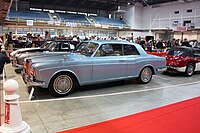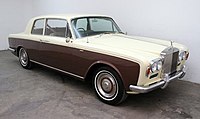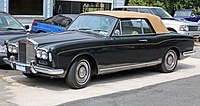Rolls-Royce Silver Shadow
| Rolls-Royce Silver Shadow | |
|---|---|
 1971 Rolls-Royce Silver Shadow | |
| Overview | |
| Manufacturer | Rolls-Royce Ltd (1965–1973) Rolls-Royce Motors (1973–1980) |
| Production | 1965–1980 30,057 produced |
| Assembly | Crewe, England |
| Body and chassis | |
| Body style |
|
| Layout | Front-engine, rear-wheel-drive |
| Related | Bentley T-series Rolls-Royce Silver Wraith II Rolls-Royce Camargue Rolls-Royce Corniche |
| Powertrain | |
| Engine | |
| Transmission | 4-speed Hydramatic automatic (1965–70; UK only) 3-speed THM 400 automatic |
| Dimensions | |
| Wheelbase | 119.5 in (3,035 mm)[2] 123.5 in (3,137 mm) (LWB) |
| Length | 203.5 in (5,169 mm) |
| Width | 71 in (1,803 mm) |
| Height | 59.75 in (1,518 mm) |
| Kerb weight | 4,648 lb (2,108 kg) |
| Chronology | |
| Predecessor | Rolls-Royce Silver Cloud III |
| Successor | Rolls-Royce Silver Spirit |
The Rolls-Royce Silver Shadow is a full-sized luxury car produced by British automaker Rolls-Royce in various forms from 1965 to 1980. It was the first of the marque to use unitary body and chassis construction.
The Silver Shadow was produced from 1965 to 1976, and the Silver Shadow II from 1977 to 1980. To date, the combined model run has the largest production volume of any Rolls-Royce.[3]
Models[]
Silver Shadow[]
The Silver Shadow was designed with several modernisations in response to concerns that the company was falling behind in automotive innovation, most notably its unitary construction.

Style-wise, the John Polwhele Blatchley design was a major departure from its predecessor, the Silver Cloud. More than 50% of Silver Clouds had been sold on the domestic market where, by the standards of much of Europe and most of North America, roads were narrow and crowded.[4] The new Shadow was 3+1⁄2 inches (8.9 cm) narrower and 7 inches (18 cm) shorter than the Silver Cloud, but nevertheless managed to offer increased passenger and luggage space thanks to more efficient packaging made possible by unitary construction.[4]
Other new features included disc brakes replacing drums, and independent rear suspension instead of the outdated live axle design of previous Rolls models.

The standard wheelbase Silver Shadow measured 203.5 inches (5,170 mm), 4,700 lb (2,100 kg) and had a book price of £6,557[5] in the first year of production.
The Shadow featured a 172 hp (128 kW) 6.2 L V8 from 1965 to 1969, and a 189 hp (141 kW) 6.75 L V8 from 1970 to 1980. Both powerplants were coupled to a General Motors-sourced Turbo Hydramatic 400 automatic gearbox, except on pre-1970 right-hand-drive models, which used the same 4-speed automatic gearbox as the Silver Cloud (also sourced from General Motors, the Hydramatic).
A distinctive feature was a high-pressure hydropneumatic suspension system licensed from Citroën, with dual-circuit braking and hydraulic self-levelling suspension. At first, both the front and rear of the car were controlled by the levelling system; the front levelling was deleted in 1969 as it had been determined that the rear levelling did almost all the work.[6] Rolls-Royce achieved a high degree of ride quality with this arrangement.

Front grill of the 1972 Silver Shadow, showing the Rolls-Royce logo and the "Spirit of Ecstasy"

"Spirit of Ecstasy" on a Rolls-Royce 1972 Silver Shadow
Two-door versions[]
A two-door saloon was introduced early in 1966, followed by a convertible in 1967.[1] There are two different versions of the two-door saloon – one by Mulliner Park Ward featuring "Coke bottle" style fenders, and the very rare James Young model that was only built in fifty examples (comprising 35 Rolls-Royces and 15 Bentleys). The James Young version was discontinued in 1967, leaving only the curvier Mulliner Park Ward model.
The convertible variant, by Mulliner Park Ward, was marketed as the Silver Shadow Drophead Coupé.[7]

1967 Silver Shadow two-door saloon by Mulliner Park Ward

1967 Silver Shadow two-door saloon by James Young

1967 Silver Shadow Drophead Coupé by Mulliner Park Ward
Silver Shadow II[]


In 1977, the model was renamed the Silver Shadow II in recognition of several major changes, most notably rack and pinion steering; modifications to the front suspension improved handling markedly.
Externally, the bumpers were changed from chrome to alloy and rubber starting with the late 1976 Silver Shadows. These new energy-absorbing bumpers had been used in the United States since 1974, as a response to tightening safety standards there. Nonetheless, the bumpers on cars sold outside of North America were still solidly mounted and protruded 2 in (5 cm) less.[8] Also now made standard across the board was the deletion of the small grilles mounted beneath the headlamps. Outside of North America, where tall curbs and the like demanded more ground clearance, a front skirt was also fitted to the Silver Shadow II and its sister cars.
In 1979, 75 Silver Shadow II cars were specially fitted to commemorate the 75th anniversary of the company with the original red "RR" badges front and rear, pewter/silver paint, grey leather with red piping, scarlet red carpets, and a silver commemorative placard on the inside of the glove box door. 33 75th anniversary cars were designated for and shipped to the North American market.
Derivatives[]
Silver Wraith II[]


Rolls-Royce considered offering a more exclusive, long-wheelbase Phantom VII model based on the Silver Shadow, but production was not pursued and no prototypes were built.[9] Instead, a long-wheelbase variant, some 4 inches longer to provide additional rear seat legroom, was offered in the United States from May 1969, and available to domestic customers from early 1970.[10] A pilot series of ten long wheelbase cars had been built in 1967 and sold, one of them to Princess Margaret.[11] Some long-wheelbase models were fitted with a privacy glass divider. Outside of North America, the cars with a divider were fitted with a separate air conditioning unit mounted in the boot - North American safety laws made this impossible, as the petrol tank would have had to be relocated. The cars with a divider lost the entire gain in wheelbase. The glass divider was electrically retractable.
Initially, the long-wheelbase model did not have a separate name, but in 1976, with the introduction of the Silver Shadow II, the longer car was dubbed the Silver Wraith II.
The Wraith II is identified by all alterations found on the Silver Shadow II and additionally an Everflex-covered roof (also available as an option on the Silver Shadow II), a smaller, more formal rear window (some customers deleted the smaller back window: for example Joe Bamford of JCB) and different wheel covers. Some Silver Wraith IIs were also fitted with electric divisions which took up the extra four inches of leg room in the rear.
The Rolls-Royce factory built a special stretch limousine in 1979. It was ordered by Bhagwan Shree Rajneesh. The religious leader had a collection of 93 Rolls-Royce cars.[12][13]
Corniche[]
In 1971 the Silver Shadow two door models were given the separate identity of Corniche (with either Rolls-Royce or Bentley badging), and eventually went on to outlive the Silver Shadow by some years with production lasting until 1982 for the coupé and 1996 for the convertible.
Camargue[]
Another coupé variant on the Shadow platform was the Camargue, with bodywork designed by the Italian firm Pininfarina, and production running from 1975 to 1986. The Camargue had the distinction of being the most expensive production Rolls-Royce.
Bentley T[]
A Bentley version of the Shadow, known as the Bentley T (and Bentley T2 from 1977), was also made. It was mechanically identical and differed only in the badging and design of the radiator shell. The more rounded radiator also required a slightly reshaped bonnet profile. Other modifications were only slight cosmetic ones, a different front bumper and hubcaps. Engine valve covers with a "Bentley" logo were only used when the factory had them available.[citation needed]
The long-wheelbase version of the Bentley T did not have a separate identity and was simply called T long-wheelbase or T2 long-wheelbase. Only a very few of these were built (9 and 10 examples respectively, less than 0.4% of the total long-wheelbase production).
All two-door cars were also available as Bentleys. However, only one example of a Bentley Camargue was ever produced.
Production statistics[]
| Model | In production | Units sold/numbers built |
|---|---|---|
| Silver Shadow | 1965–1977 | 16,717 |
| Silver Shadow II | 1977–1980 | 8425 |
| Total | 25,142[14] |
| Model | In production | Units sold/numbers built |
|---|---|---|
| Silver Shadow LWB | 1969–1977 | 2780 |
| Silver Wraith II | 1975–1980 | 2135 |
| Total | 4915[14] |
Popular culture[]
The Silver Wraith II (1977 at least, it is not entirely clear which model year the vehicle is) makes multiple appearances in the first season of Netflix's The Umbrella Academy. It is first very briefly revealed at the end of the series' first episode, "We Only See Each Other at Weddings and Funerals". The same vehicle later makes a clearer appearance at the end of "Number Five". It also appears in the beginning and end of "The Day That Was" and of "I Heard a Rumor". It is seen for the last time at the beginning of "Changes".[citation needed]
References[]
- ^ Jump up to: a b All 33 models, www.rrsilvershadow.com. Retrieved 25 April 2015.
- ^ Cardew, Basil (1966). Daily Express Review of the 1966 Motor Show. London: Beaverbrook Newspapers Ltd.
- ^ James May's Cars of the people, S1E3 - "To try and keep up with demand for all thse new money buyers springing up all over the place, they over-produced: More Silver Shadows were produced than any other Rolls Royce."
- ^ Jump up to: a b "The doughty dowager comes of age". Car and Driver. 11 nbr 9: 45–47. March 1966.
- ^ "Recommended New Car Prices". Autocar. Vol. 124 (nbr 3656). 11 March 1966. p. 537.
- ^ http://www.rrsilvershadow.com/Emenu/hydr.htm
- ^ 1968 Rolls Royce Silver Shadow Drophead Coupe Brochure Right Hand Drive wv4249, www.ebay.ie As archived at web.archive.org
- ^ Bobbitt, p. 112
- ^ "The Rolls-Royce Photo Archive". Luxurycarphotos.tripod.com. Retrieved 24 October 2009.
- ^ "More substance for the Shadow: Long wheelbase Rolls-Royce introduced". Motor. Vol. nbr 3492. 24 May 1969. p. 45.
- ^ Bobbitt, p. 129
- ^ Palmer 1988, p. 128, reprinted in Aveling 1999, p. 380
- ^ Pellissier, Hank (14 May 2011). "The Bay Citizen: Red Rock Island". The New York Times. Archived from the original on 24 March 2012. Retrieved 10 July 2011.
- ^ Jump up to: a b c d "Rolls-Royce Silver Shadow and Bentley 'T' series". Queensland, Australia: Rolls Royce Owners Club of Australia, Queensland Branch. Archived from the original on 12 October 2009. Retrieved 25 October 2010.
Literature[]
- Graham Robson: Rolls Royce Silver Shadow: The Complete Story, 1998, ISBN 1861261160.
- R. M. Clarke: Rolls-Royce Silver Shadow Ultimate Portfolio, 1999
- Bobbitt, Malcolm (1996), Rolls-Royce Silver Shadow, Bentley T-series, Camargue & Corniche (3rd (2004) ed.), Dorchester, Dorset, UK: Veloce, ISBN 1-904788-25-4
External links[]
| Wikimedia Commons has media related to Rolls-Royce Silver Shadow. |
| hide | ||||||||||||||||||||||||||||||||||||||
|---|---|---|---|---|---|---|---|---|---|---|---|---|---|---|---|---|---|---|---|---|---|---|---|---|---|---|---|---|---|---|---|---|---|---|---|---|---|---|
| Type | 1900s | 1910s | 1920s | 1930s | 1940s | 1950s | 1960s | 1970s | 1980s | 1990s | 2000s | 2010s | 2020s | |||||||||||||||||||||||||
| Ownership | Independent | Vickers plc | VW Group | BMW | ||||||||||||||||||||||||||||||||||
| Sedan & Others | 10 hp 15 hp |
V-8 20 hp |
Twenty | 20/25 | 25/30 | Wraith | World War II | Silver Dawn | Silver Cloud | Silver Shadow | Silver Spirit | Silver Seraph | Ghost | |||||||||||||||||||||||||
| Sedan & Others | 30 hp | 40/50 hp (Silver Ghost) |
Phantom I/II/III | Silver Wraith | Silver Wraith II | Silver Spur | Ghost Extended Wheelbase | |||||||||||||||||||||||||||||||
| Phantom IV | Phantom V | Phantom VI | Touring Limousine | Park Ward | Phantom VII | Phantom VIII | ||||||||||||||||||||||||||||||||
| Convertible | Dawn | |||||||||||||||||||||||||||||||||||||
| 2 door | Corniche/II/III/IV | Corniche V | Phantom Drophead | Boat Tail | ||||||||||||||||||||||||||||||||||
| Coupé | 2 door | Corniche and Camargue | Silver Spirit Hooper 2 door | Sweptail | Wraith | |||||||||||||||||||||||||||||||||
| Phantom Coupé | ||||||||||||||||||||||||||||||||||||||
| SUV | Cullinan | |||||||||||||||||||||||||||||||||||||
- Full-size vehicles
- 1970s cars
- Rolls-Royce vehicles
- Rear-wheel-drive vehicles
- Sedans
- Limousines
- Cars introduced in 1965




